The automaker makes a solid case for fuel cells as an alternative to — not a replacement for! — battery power
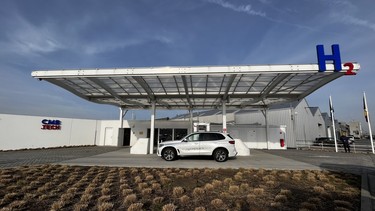
Article content
I know you know the frustration. When something truly obvious just jumps out at you. You know, the old smack-your-head why-didn’t-I-think-of-that realization that, shit, I, too, could have invented something that I could be peddling like some modern-day George Foreman or Ron Popeil.
Advertisement 2
Article content
Now, understand me well; I have no delusions of genius. I’m not talking about one of those apple-falls-on-your-head “Oh, my God, gravity!” moments that separate true brilliance from mere intellectual grinding. Nope, I’m thinking about one of those everyday how-the-hell-did-I-miss-that realizations every time you are faced with yet another miracle Panel Clip Removal Plier or the ALL-NEW! REVOLUTIONARY! quick-release multiple-terminal Convenient (Battery) Terminal Connector on Facebook Marketplace.
I had just my latest in so-that’s-what-I’ve-been-missing moments last week, during a tech talk with BMW’s General Project Manager Hydrogen Technology and Vehicle Projects, Juergen Guldner. For the last two or three years, I’ve had a nagging suspicion that just beyond my reach was a rebuttal to the argument that battery-powered cars are endemically more efficient than hydrogen-powered fuel-cell vehicles. I pondered the question. I researched tank-to-wheels efficiency to death. Then I pondered some more. Nothing. Nada. Not a clue of what I’ve been missing. Just the frustration of believing — nay, knowing — that I was missing something just beyond my grasp.
Advertisement 3
Article content
-
![Motor Mouth answers all of your hydrogen questions]()
Motor Mouth answers all of your hydrogen questions
-
![Motor Mouth Podcast: The rising fortunes of hydrogen as fuel, and the perils of EV fires]()
Motor Mouth Podcast: The rising fortunes of hydrogen as fuel, and the perils of EV fires
It took but a three-second glance at the 11th slide in Gunder’s BMW iX5: The EV with Fast Refuelling presentation for my “aha!” moment to manifest. The logic was so obvious, I really thought one of those cartoon-style light bulbs might appear above my head. Besides yet another sad affirmation that recognizing other people’s brilliance will always be as close to actually being brilliant as I will ever get, what Guldner’s presentation illuminated is that, while BEVs will always be more efficient than FCEVs on a tank-to-wheels basis, in a sun-to-wheels match-up, the two technologies are almost on an even footing.
Advertisement 4
Article content
Here’s his reasoning. Or at least, my brilliance-adjacent explanation of it.
For zero-emissions vehicles to be truly non-polluting, they need to be “fuelled” by clean, green energy. That much is well understood by all. The issue that Guldner is raising, however, is the efficiency of that fuel’s generation. More importantly, that we should be concerned not just with the efficiency of how renewable energy is created, but more importantly where it is collected.
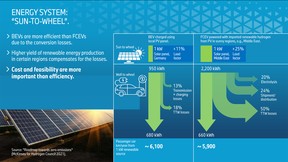
By way of example, Guldner uses solar panels. All solar panels, give or take an advertising exaggeration or two, are relatively equal. But where they collect their renewable energy is not. According to the McKinsey study Guldner sourced his information from, a solar panel located in Germany is about 11-per-cent efficient. In other words, as a result of the changing angle of the sun, Germany’s climatic conditions, and sundry other limitations, a solar panel located in his home country would collect but 11 per cent of its theoretical maximum of 8,760 kilowatt-hours in a year (24 hours a day times 365 days in a year times one kilowatt).
Advertisement 5
Article content
In sun-drenched Saudi Arabia, on the other hand, that very same solar panel would be about 25-per-cent efficient on a yearly basis, a more than two-fold increase in energy-generating efficiency. For those at all familiar with the BEV-versus-FCEV efficiency argument — the essence of which is that, in first using electricity to convert water into hydrogen and then later reconverting that same hydrogen back into electricity, FCEVs’ use of energy will always be inferior — that difference is almost exactly the same margin that EV proponents claim a battery-powered car is more efficient than a fuel cell.
Indeed, in Guldner’s real-world, engineering-theory-be-damned calculations, an FCEV powered by hydrogen sourced from a one-kilowatt solar panel located in the Middle East could travel 5,900 kilometres in a year. A BEV powered by a charging station fed from a similar one-kW solar panel located in Germany could eke out 6,100 km, just 200 kilometres more. That’s a barely three-per-cent deficit for a vehicle than can recharge about 10 times as quickly. “Fool cells” indeed, Elon.
Advertisement 6
Article content
In other words, in Germany, fuel-cell vehicles can be directly competitive with electric vehicles on a well-to-wheels — actually, that’s sun-to-wheels — basis
Now, to be sure, these calculations don’t work in all cases. Like, anywhere with an abundance of hydroelectric power. Or with a populace accepting of nuclear power. But, as Guldner points out, Germany is blessed with neither, and, like all of Europe, must import much of its energy.
And, unfortunately for the BEV-is-always-superior crowd, liquid fuel is, by far, the most transportable of energy mediums. A transmission line from the Arabian peninsula, for instance, is just silly. So would be any kind of battery solution. Indeed, Guldner’s numbers even account for the production of hydrogen in Middle East and the energy to ship it to Germany. In other words, in Germany, fuel-cell vehicles can be directly competitive with electric vehicles on a well-to-wheels — actually, that’s sun-to-wheels — basis. Hence why Guldner — and BMW — is putting so much effort into developing its hydrogen technology.
Advertisement 7
Article content
Nor are BMW’s innovations restricted to hydrogen production. For instance, though the automaker uses Toyota fuel cells to underpin its new iX5 FCEV’s core technology, how BMW builds those cells into a “stack” speaks to the ingenuity we’ve come to expect from Bayerische Motoren Werke.
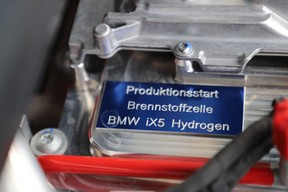
The secret sauce, says Guldner, is that, much like a battery, how many of those fuel cells you can squeeze into a stack pretty much determines its worthiness. Unlike battery cells – or at least the ones used in most EVs — a fuel cell is somewhat compressible, a trait Guldner and team are pushing to its extreme. In their prototyping, for instance, after they’ve stacked “several hundred” wafer-thin cells into a module, they then compress them with a five-tonne press, reducing their volume by some 30 per cent. More cells in a smaller space means a more powerful fuel cell.
Advertisement 8
Article content
In fact, BMW says the iX5’s 125-kW unit is the most powerful stack in a production vehicle yet assembled — if you call 100 show cars “production” — powerful enough to cruise the autobahn at a steady, completely-fuelled-by-net-zero-hydrogen 185 kilometres an hour.
No, that’s not nearly as fast as a Tesla. But BMW does get its revenge. As Robert Halas, BMW‘s project manager for the iX5 explains, often, when he’s out for a friendly “cruise,” the Tesla boys blast by him. Only for a little while, he smiles, because range anxiety is worse — much worse — at autobahn speeds. And when they stop for a recharge, it’s often as the same spot as Halas pops in for a hydrogen top-up (there are no fewer than 105 hydrogen stations in Germany, some of them with two pumps).
Inevitably, the chief engineer says, the Tesla owners come over for a quick chat about his new iX5. But, while he doesn’t at all mind taking the time to explain the various intricacies and benefits of his fuel-cell vehicle, by far his favourite part of this interaction is that, three minutes or so into the conversation, he has to apologize with an “Oops, it looks like I’m already full, so that’s me gone, fellas!” “Fool cells” indeed, Elon.
Advertisement 9
Article content
What Halas is even more proud of, however, is how efficiently he and his team have been able to incorporate hydrogen into the existing X5. A bare-framed prototype of the iX5 chassis reveals that precious little of the framework needed modification in the conversion from ICE-power to FCEV. In fact, says Halas, not a single dimension of the X5 — seat room, cargo capacity, or interior volume — has been compromised in the ditching of pistons for fuel cells, the current X5 platform easily accommodating both powertrains.
Even more impressively, BMW says its new upcoming Neue Klasse platform will be completely powertrain-agnostic, only, in this case, with the ability to switch between battery and fuel-cell power without modification. Essentially, says Halas, BMW has developed a way to build hydrogen tank(s) compact enough to fit into the same floor space as the electric version’s lithium-ion battery pack and yet still carry the six kilograms of high-pressure hydrogen needed for 500 kilometres of WLTP-rated range. Since most of the rest of their powertrains — electric motors, inverters, etc. — are either identical or very similar, BEV and FCEV versions will share almost all components and can be built on the same line.
Advertisement 10
Article content
“Fool cells” indeed, Elon.
Author’s note: For all the Tesla fanatics out there already penning screeds that their BEVs are superior (for them), understand that neither Motor Mouth nor BMW is advocating that FCEV tech should power all — or even a majority — of light-duty vehicles around the world. For one, Germany’s energy conundrum is not universal. For another, those with short commutes and infrequent road trips are indeed best served by a charge-at-home battery-powered car.
But cleaning up the transportation industry’s tailpipe emissions needs all net-zero hands on deck. Both BEVs and FCEVs reduce our carbon footprint, and therefore both will be necessary powertrains of the future. Indeed, according to some McKinsey numbers — which form the bases of Guldner’s thesis — a mix of EV recharging and FCEV hydrogen-refueling stations is the least expensive way to build the automobile refuelling infrastructure of the future.
Advertisement 11
Article content
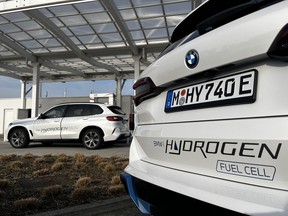
The reasoning goes like this: recharging stations, as expensive as they are — as much as a hundred grand for a truly high-powered DC fast-charger — are still much less expensive than a hydrogen refueller, so in the initial roll-out, the incremental costs of building out a country-wide infrastructure is less onerous. However, as ZEVs become more popular, hydrogen stations, because they replenish FCEVs so much more quickly, become cheaper on a per-car basis. In other words, in areas of high refuelling concentration, hydrogen stations make more sense; while in less-frequently used areas, battery recharging stations may prove more economical.
Indeed, according to McKinsey, the ideal situation is a split between the two, its Road to Net Zero analysis showing that even with a low adoption rate of FCEVs (15 per cent of passenger cars, and 41 per cent of heavy-duty vehicles) there is a 20-per-cent reduction in overall infrastructure costs. Adopting even more FCEVs (52 per cent of light-duty vehicles, and 64 per cent HDVs) would reduce those infrastructure costs another 14 per cent.
These numbers are all based on European driving habits, transportation needs, and energy supplies. However, while the numbers might change for North America — or, for Africa, South America, the Far East, and even Australia, for that matter — they remain proof that the one-size-fits-all, BEV-is-all-we-need argument just doesn’t hold water.
Stay connected with us on social media platform for instant update click here to join our Twitter, & Facebook
We are now on Telegram. Click here to join our channel (@TechiUpdate) and stay updated with the latest Technology headlines.
For all the latest Automobiles News Click Here


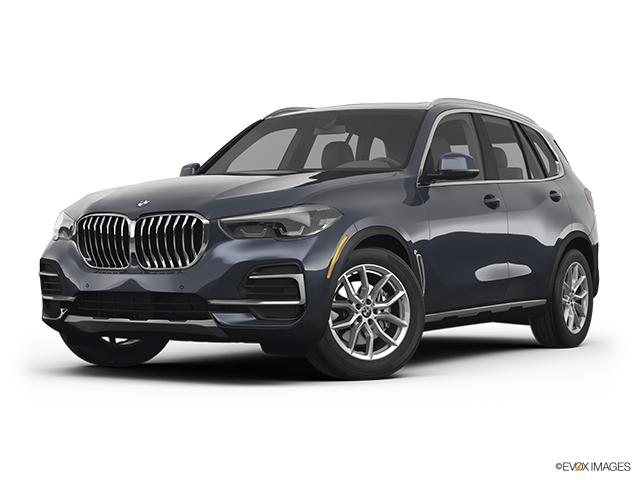
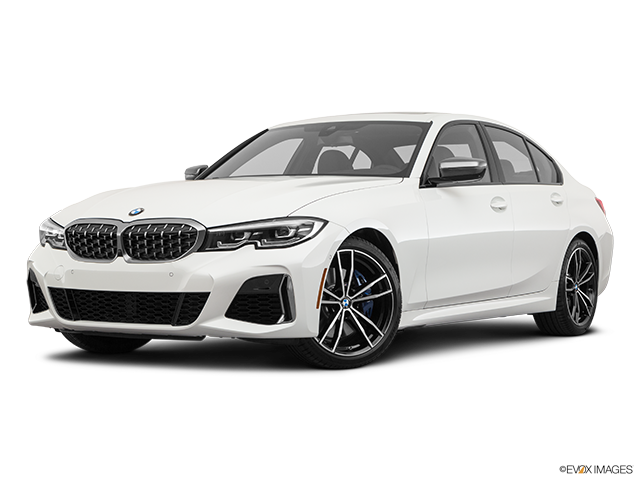
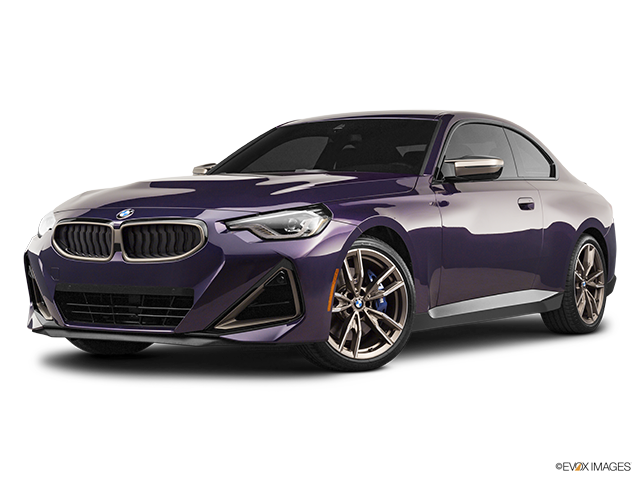




Comments
Postmedia is committed to maintaining a lively but civil forum for discussion and encourage all readers to share their views on our articles. Comments may take up to an hour for moderation before appearing on the site. We ask you to keep your comments relevant and respectful. We have enabled email notifications—you will now receive an email if you receive a reply to your comment, there is an update to a comment thread you follow or if a user you follow comments. Visit our Community Guidelines for more information and details on how to adjust your email settings.
Join the Conversation